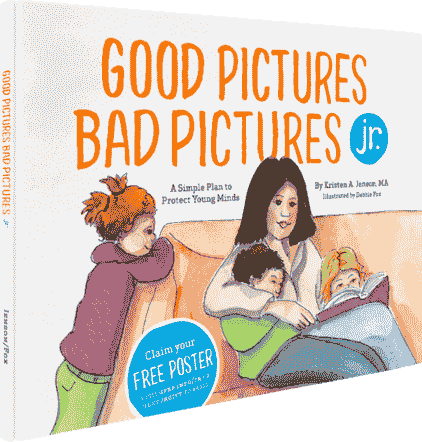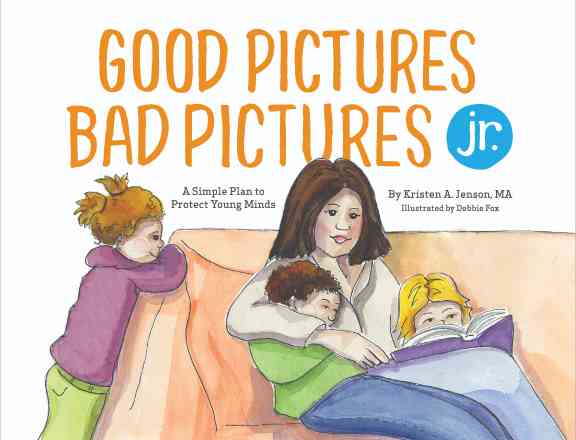

The #1 Thing Kids Need to Know to Stop Grooming and Prevent Sexual Abuse
Sexual predators don’t just appear in dark alleys—they often use the device in the palm of a child’s hand, waiting for the right moment to use technology to sexually exploit kids.
One of the most common tools they use to groom a child?
Pornography.

That might sound alarming—but it’s true.
Sometimes, the predator is someone the child knows and trusts, including:
- A cousin
- A neighbor
- A friend of the family
- An older teen helping out with younger kids
In fact, 93% of child sexual abuse is committed by someone the child knows. These predators often build trust over time—using attention, gifts, or flattery to lower a child’s defenses and gain their trust.
Other times, it’s a stranger hiding behind a username on a game like Roblox or sending messages through social media.
But whether it’s a familiar face or a total stranger, the tactic is often the same:
“Hey, look at this.”
- They pull out a phone.
- They share an explicit video.
- They send an image or a meme—testing how the child reacts to sexually explicit content.
The goal? To introduce sexual content early—on their terms. To normalize it. To chip away at a child’s boundaries and confuse their understanding of what’s safe and appropriate.
That’s why teaching kids to recognize and reject pornography is such a crucial part of sexual abuse prevention.
Related:
The 3 Big Red Flags of Sexual Abuse
Teach Kids Body Safety: Top 9 Books That Help Prevent Sexual Abuse
How predators groom kids using pornography—in person and online
Grooming can happen in the most familiar places:
- At a family gathering
- During a sleepover or playdate
- In the back seat during a carpool or on the school bus
- At school, church, or a community event
Even in these trusted spaces, someone your child knows might casually show them something inappropriate on a phone or tablet. Sometimes, it’s framed as a joke or “just a game.” Other times, it’s part of a deliberate pattern of desensitization—testing their boundaries.
Child groomed by stepfather using pornography
A forensic interviewer from a Child Advocacy Center who was on our Parent Advisory Council reported that she often hears about porn as a grooming tool during interviews with victims.
She shared the story of a 13-year-old girl who came in for suicidal thoughts. During the investigation, the girl disclosed that her stepfather had been sexually abusing her from the age of 10—and that he used pornography to groom her.
His threats weren’t overt—just quiet warnings like, “We’ll both get in trouble if you tell.” But they were enough to keep her silent for years.
The interviewer reflected that if this child had been taught to recognize pornography as unsafe and to tell a trusted adult when exposed to it, the abuse might have been prevented.
Grooming through games, apps, and social media
Online grooming looks a little different. Many predators use games, chat apps, and social media to reach kids. They use tactics like:
- Sending a message or link “just for fun.”
- Using memes, challenges, or fake profiles to lower a child’s guard.
- Gradually escalating the content shared or requested.
Sometimes, they even work together.
For example, in a recent Utah case, a county judge and a fire chief were both charged with child sexual exploitation. Investigators say they used an online chat app to exchange sexually explicit material, discuss harming children, and even coordinated with one another.
One of the men was accused of distributing explicit content of preteen girls, while the other allegedly enticed minors using a chat app, and shared graphic messages about real children he knew.
Related: Pedophiles Hunt Kids in Popular Gaming Apps: Roblox, Minecraft, & Fortnite
Group grooming and online sexual exploitation: What every parent should know
This kind of collaboration is exactly what the FBI refers to as group grooming—when multiple predators work together to target and manipulate children.
According to the FBI, offenders may pose as other children in chat groups or games, gradually introducing sexually explicit content and normalizing abuse through peer pressure and false trust.
“If you have somebody that's pretending to be a child and doing it effectively, that normalizes what that person is saying. And it's all the more effective if it's not just one person, but multiple people saying that.”
—Robert Tripp, special agent in charge of the FBI's San Francisco office
Whether working alone or in groups, online, or in person, predators often use pornographic images/videos or sexual conversations to desensitize and manipulate their victims. When kids don’t know how to respond—or don’t feel empowered to speak up—it becomes easier for offenders to escalate the abuse.
In each scenario, pornography is used as a tool to erode a child’s natural sense of safety.
Why teaching porn rejection is crucial for child sexual abuse prevention
Why is porn rejection a body safety skill?
Lisa Thompson, Vice President of the National Center on Sexual Exploitation (NCOSE), said it best:
“There's no doubt in my mind — none, nada, zero, that a child who has been educated about how to reject pornography would also be safer from sex traffickers and sexual exploiters of any kind.”
In other words, when we teach kids how to recognize and reject pornography, we’re not just protecting them from a single danger. We’re helping them stand up to anyone—whether it’s a sexual abuser, a trafficker, or an online exploiter—who tries to manipulate them using sexual content.
This kind of prevention starts with simple, clear language. Lisa also shared how that looks in real life:
“If they’ve been taught to reject pornography, they’re not going to look at it. They’re going to say, ‘Oh, that’s not a good picture. I’m not going to look at that,’ and then they’ll tell a trusted adult.”
That kind of clarity doesn’t just appear on its own. It comes from intentional, age-appropriate conversations—and can make all the difference.
We often teach kids about body boundaries and how to say “no” to inappropriate touch. But in today’s world, those lessons need to include the digital grooming tactics predators use—especially the strategic use of pornography.
[[CTA]]
How to talk to your kids about pornography
You don’t need to have all the answers. What matters most is that your child knows they can talk to you about anything—even awkward or confusing topics like pornography.
Here are a few simple ways to begin:
- “Have you ever seen a picture or video online that made you feel weird or uncomfortable?”
- “If you ever come across something like that, you won’t be in trouble. I just want you to come tell me.”
- “Some people might try to show kids pictures of people without their clothes on. Those are bad pictures. Do you know what to do if that happens?”
Keep it calm. Keep it short. And most importantly, keep having these conversations.
Side-by-side chats—like while driving, cooking, or reading together—can make awkward conversations feel less intimidating.
Related: It’s Awkward, and It’s OK: You CAN Talk to Your Kids About Pornography
Porn-proofing tools to help you get started
Need help getting started with talking to your child about pornography? Here are five resources to make it easier:
1. Good Pictures Bad Pictures: Porn-Proofing Today’s Young Kids (ages 7-11)
- An Amazon best-selling read-aloud book that teaches kids how to recognize and reject pornography using the CAN DO Plan
- Page 1: Opens the conversation about “bad pictures”
- Page 31: Explains the CAN DO Plan
- Page 37: Includes a QR code to download a free printable CAN DO Plan poster
2. Good Pictures Bad Pictures Jr.: A Simple Plan to Protect Young Minds (ages 3-7)
- Uses gentle, age-appropriate language for little ones
- Page 14: Defines “bad pictures” in simple terms
- Page 18: Teaches where they might see a bad picture
- Page 26: Introduces the “Turn, Run, and Tell” strategy
- Page 31: Lists five simple body safety rules
Note: If you’ve already read Good Pictures Bad Pictures with your child, you have a powerful tool for preventing sexual abuse right on your shelf. You can revisit specific pages to reinforce what to do if someone shows your child pornography. Repetition builds confidence and readiness.
3. Brain Defense: Digital Safety Curriculum
- A kid-to-kid digital safety program with entertaining videos, engaging workbooks, and family activities
- Teaches digital safety to children in classrooms or at home
4. How to Talk to Kids About Pornography
- A free digital guide with step-by-step scripts and conversation starters for every age
5. Prepare Kids to Reject Pornography
- A growing collection of regularly published articles covering new trends, digital risks, and practical ways to protect kids
- Features our most up-to-date insights, tips, and tools to help you raise porn-resilient kids
Every conversation, every resource, every strategy you use is like building armor for your child. And layer by layer that armor matters.
Keep kids safer from sexual abuse: Teach them to reject pornography
Predators are clever, and technology gives them more ways than ever to reach and groom kids. But you are your child’s first and best line of defense.
When your child knows how to respond—when they can recognize pornography for what it is and reject it—they become much harder to groom or manipulate. They can recognize red flags sooner. They can respond more clearly and confidently.
They’ll know to say:
“That’s not a good picture. I’m not going to look at that.”
And just as importantly, they’ll know what to do next:
Tell a trusted adult.
That one simple sentence, followed by the simple action of turning away and telling someone, can interrupt a grooming attempt before it escalates to sexual abuse.
So start the conversation today. Be the first voice they hear about pornography—so they’ll know how to respond when someone tries to show it to them.
Use our books, guides, and digital safety curriculum to make it easier.



Good Pictures Bad Pictures Jr.
“I highly recommend this book to all people with children. A must have for all parents!” —Amazon Review







